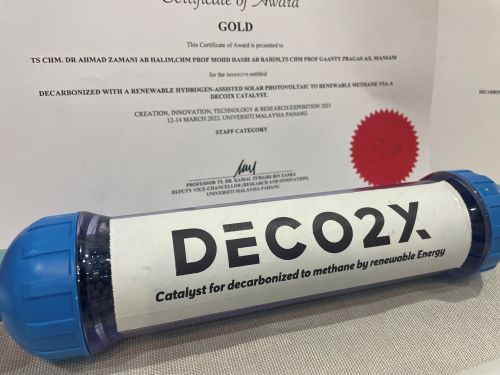
### A Highly Effective Cobalt Terpyridine-based Catalyst for CO₂ Conversion to Methane
The issue of climate change calls for creative solutions to efficiently capture and repurpose carbon dioxide (CO₂), a significant factor in global warming. In this endeavor, researchers have continuously explored effective methods to transform CO₂, a byproduct of many industrial activities, into methane (CH₄), a viable fuel. Recently, a team from the Universities of Bonn and Montreal has introduced a groundbreaking advancement: an exceptionally effective cobalt terpyridine-based catalyst capable of converting CO₂ into methane. This catalyst utilizes a distinctive mechanism by functioning at the gas-liquid-solid interface, presenting a novel and improved route for transforming waste CO₂ into valuable products.
#### The Catalyst’s Distinct Operating Mechanism
Historically, the conversion of CO₂ into methane or other hydrocarbons has been particularly challenging due to the intricate physical and chemical reactions involved. CO₂ is in its gaseous form, while water—crucial for hydrogenation—remains in liquid form. Facilitating a reaction between these two phases under standard conditions has proven difficult, as they do not naturally mix well. Moreover, water tends to engage in competing side reactions, like forming hydrogen or oxygen, instead of supplying hydrogen atoms for the CO₂ conversion process.
The innovative cobalt terpyridine-based catalyst devised by the Bonn-Montreal research group addresses these challenges by concentrating on the interaction at the gas-liquid-solid interface. This interface is established using a gas diffusion electrode, onto which the researchers apply their advanced catalyst. The catalyst’s primary function hinges on its active center, where CO₂ is captured, and the connection between carbon and oxygen in the CO₂ molecule is weakened through an electrochemical reaction with the catalyst.
#### Water-Repelling Side Chains: Mitigating Side Reactions
A major challenge in CO₂ reduction is the propensity of water to participate in side reactions. Rather than relying on chemical or thermal energy, which may require significant pressures and temperatures, the research team employs electricity as the energizing force for the methane production process. To enhance chemical efficiency and limit water’s involvement in diverting the reaction, the cobalt terpyridine catalyst features lengthy, hydrophobic perfluorinated alkyl side chains. These hydrophobic chains repel water from non-essential reaction areas, lessening the chances of unwanted side reactions such as oxygen evolution.
The hydrophobic side chains also provide an added advantage—they function as a “proton conveyor belt.” These specially designed chains capture hydrogen atoms from water molecules and transfer them directly to the catalyst’s active site. Here, the hydrogen atoms substitute oxygen atoms released from the CO₂ molecule via electrocatalysis, successfully completing the conversion into methane.
#### Efficiency and Current Hurdles
The researchers have reported an impressive conversion efficiency, achieving over 80% methane production with minimal yields of unwanted byproducts like carbon monoxide or hydrogen. This remarkable efficiency is a significant achievement, indicating that electrocatalytic CO₂ reduction could serve as a viable method for generating methane, which can be repurposed for energy storage or industrial applications.
Nevertheless, challenges remain to be overcome. The current system is not yet suited for large-scale methane production, primarily due to the potential for electrode flooding. The catalyst operates within the interface of three distinct phases—gas, liquid, and solid—making it essential to maintain the proper balance of hydration and desiccation for optimal operation. Over time, changes in hydration at this interface can diminish the reaction’s efficiency and lead to a gradual decline in performance.
#### Future Perspectives: Broadening Beyond Methane
Although methane production is an exciting milestone, this innovative process and mechanism have wider industrial implications. The reaction principles established in this framework could be modified to generate other valuable chemicals. For example, the techniques developed by the team may enable the synthesis of ethylene, a crucial precursor in plastic manufacturing. Since ethylene serves as a vital feedstock for a diverse range of polymers, enhancing its production through more sustainable methods could help minimize the environmental impact of the plastics industry.
Potential routes for ethylene production would entail modifying the reaction conditions, such as adjusting electrocatalytic temperature and voltage, to encourage hydrocarbon chain elongation instead of methanation. If successful, this could provide industry with new methods for producing plastics and chemicals, significantly lowering their overall carbon footprint.
#### Addressing the Climate Crisis with Catalysis
As the global community confronts rising CO₂ levels and climate change, innovative chemical solutions are vital for reducing emissions and converting waste materials like CO₂ into useful products. The advancement of this cobalt terpyridine-based catalyst moves us closer to realizing a circular carbon economy where CO₂ emissions are captured and transformed into valuable, recyclable resources.
Additionally, using electricity as the catalyst’s driving force paves the way for integration with renewable energy sources, such as solar and wind. By capturing CO₂ and converting it into methane or other chemicals during times of abundant renewable energy, this pioneering catalytic process could enhance the sustainability of the energy grid while mitigating